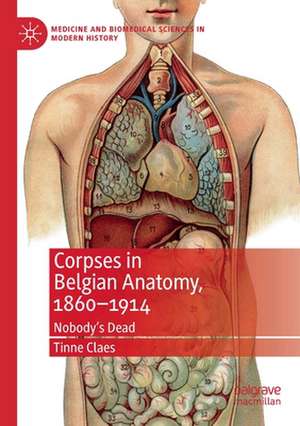Corpses in Belgian Anatomy, 1860–1914: Nobody’s Dead: Medicine and Biomedical Sciences in Modern History
Autor Tinne Claesen Limba Engleză Paperback – 2 dec 2020
| Toate formatele și edițiile | Preț | Express |
|---|---|---|
| Paperback (1) | 454.16 lei 6-8 săpt. | |
| Springer International Publishing – 2 dec 2020 | 454.16 lei 6-8 săpt. | |
| Hardback (1) | 495.52 lei 3-5 săpt. | +24.57 lei 4-10 zile |
| Springer International Publishing – 2 dec 2019 | 495.52 lei 3-5 săpt. | +24.57 lei 4-10 zile |
Din seria Medicine and Biomedical Sciences in Modern History
- 20%
 Preț: 691.97 lei
Preț: 691.97 lei -
 Preț: 282.19 lei
Preț: 282.19 lei - 20%
 Preț: 691.10 lei
Preț: 691.10 lei - 18%
 Preț: 781.77 lei
Preț: 781.77 lei - 15%
 Preț: 650.69 lei
Preț: 650.69 lei - 15%
 Preț: 584.26 lei
Preț: 584.26 lei - 15%
 Preț: 645.14 lei
Preț: 645.14 lei - 18%
 Preț: 727.80 lei
Preț: 727.80 lei -
 Preț: 167.93 lei
Preț: 167.93 lei - 18%
 Preț: 786.04 lei
Preț: 786.04 lei - 15%
 Preț: 650.37 lei
Preț: 650.37 lei -
 Preț: 231.67 lei
Preț: 231.67 lei - 15%
 Preț: 585.90 lei
Preț: 585.90 lei -
 Preț: 220.13 lei
Preț: 220.13 lei - 15%
 Preț: 585.40 lei
Preț: 585.40 lei - 18%
 Preț: 997.71 lei
Preț: 997.71 lei - 18%
 Preț: 785.11 lei
Preț: 785.11 lei - 18%
 Preț: 780.68 lei
Preț: 780.68 lei - 15%
 Preț: 643.00 lei
Preț: 643.00 lei - 18%
 Preț: 780.68 lei
Preț: 780.68 lei - 18%
 Preț: 900.94 lei
Preț: 900.94 lei - 18%
 Preț: 732.52 lei
Preț: 732.52 lei
Preț: 454.16 lei
Nou
Puncte Express: 681
Preț estimativ în valută:
86.93€ • 94.46$ • 73.07£
86.93€ • 94.46$ • 73.07£
Carte tipărită la comandă
Livrare economică 22 aprilie-06 mai
Preluare comenzi: 021 569.72.76
Specificații
ISBN-13: 9783030201173
ISBN-10: 3030201171
Pagini: 323
Ilustrații: XV, 323 p. 21 illus.
Dimensiuni: 148 x 210 mm
Greutate: 0.41 kg
Ediția:1st ed. 2019
Editura: Springer International Publishing
Colecția Palgrave Macmillan
Seria Medicine and Biomedical Sciences in Modern History
Locul publicării:Cham, Switzerland
ISBN-10: 3030201171
Pagini: 323
Ilustrații: XV, 323 p. 21 illus.
Dimensiuni: 148 x 210 mm
Greutate: 0.41 kg
Ediția:1st ed. 2019
Editura: Springer International Publishing
Colecția Palgrave Macmillan
Seria Medicine and Biomedical Sciences in Modern History
Locul publicării:Cham, Switzerland
Cuprins
1 Introduction.- 2 Anatomy is Done?.- 3 From Deathbed to Dissecting Table: Acquiring Anatomical Material.- 4 Under the Scalpel: Dividing the Body.- 5 The Jar and the Coffin: Keeping and Disposing of the Dead.- 6 Conclusion.
Recenzii
“Tinne Claes has written a wonderful study on anatomy in fin-de-siècle Belgium. This book is certainly greater than its parts and will provide intellectual sustenance and great pleasure to all those who read it. … What Claes has produced is a fascinating, thought-provoking and extremely valuable contribution to our understanding of the development of the modernist society in the Western World which forms the basis for most current debates about what it is to be a social human.” (Ross L. Jones, Metascience, Vol. 30, 2021)
Notă biografică
Tinne Claes is a Postdoctoral Researcher at the Cultural History since 1750 Research Group at the University of Leuven, Belgium, and Fellow of the Research Foundation – Flanders (FWO), Belgium.
Textul de pe ultima copertă
This book tells the story of the thousands of corpses that ended up in the hands of anatomists in the late nineteenth and early twentieth centuries. Composed as a travel story from the point of view of the cadaver, this study offers a full-blown cultural history of death and dissection, with insights that easily go beyond the history of anatomy and the specific case of Belgium. From acquisition to disposal, the trajectories of the corpse changed under the influence of social policies, ideological tensions, religious sensitivities, cultures of death and broader changes in the field of medical ethics. Anatomists increasingly had to reconcile their ways with the diverse meanings that the dead body held. To a certain extent, as this book argues, they started to treat the corpse as subject rather than object. Interweaving broad historical evolutions with detailed case studies, this book offers unique insights into a field dominated by Anglo-American perspectives, evaluating the similaritiesand differences within other European contexts.
Caracteristici
Examines the impact of changing medical practices and cultural attitudes towards death and the donation of bodies to medical facilities at the turn of the twentieth century Takes a unique methodological approach, following the trajectory of the corpse in anatomy from acquisition to disposal Offers new insights into understudied European centres, drawing comparisons with other continental cases and showing how religious and cultural ideas influenced the practice of dissection
